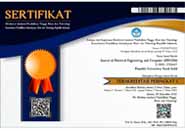Prototype of Automatic Plant Watering Control Based on Internet of Things Using Blynk App
Authors (s)
(1) * Delila Permatasari
 (Politeknik Negeri Malang)
(Politeknik Negeri Malang) Indonesia
(2) Erlillah Rizqi Kusuma (Politeknik Negeri Malang)
Indonesia
(3) Irfin Sandra Asti (Politeknik Negeri Malang)
Indonesia
(*) Corresponding Author
AbstractOrnamental plants can grow both indoors and outdoors and can also be used for room decoration. Problems arise when plants don't get the water they need, resulting in insufficient or excessive watering, which can lead to poor growth. Therefore, the purpose of this research is to create a prototype automatic plant watering system to meet plant water needs. An automatic plant watering control system uses an on-off solenoid valve. This automatic plant watering system utilizes a monitoring method that can be remotely monitored using the Blynk IoT (Internet of Things) application in real time to determine soil moisture levels and indicators.Test results showed an average error value for ultrasonic sensor measurements of 0.65%. In soil moisture testing, the soil was dry at less than 38% humidity, damp at 38%-65% humidity, and wet at more than 65% humidity. The test results showed that the DC motor pump output will operate to flow water to the water storage tank if the ultrasonic sensor in the water tank measures the water level below the set point of 10 cm. The solenoid valve will be activated to flow water for the plant watering process if the soil moisture sensor detects a soil moisture value of less than 38%, then the solenoid will be activated until the soil moisture indicator value reaches 65%.
|
Full Text: PDF
Refbacks
- There are currently no refbacks.
Copyright (c) 2025 Delila Permatasari

This work is licensed under a Creative Commons Attribution License (CC BY-SA 4.0)
Journal of Electrical Engineering and Computer (JEECOM)
Published by LP3M Nurul Jadid University, Indonesia, Probolinggo, East Java, Indonesia.








